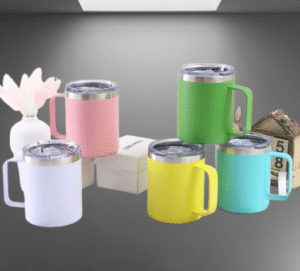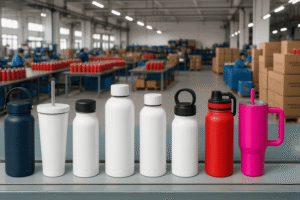You see countless mugs every day, and they all seem so similar. This makes choosing the right material for your product line confusing and potentially risky for your brand.
Most mugs are made from ceramic, specifically stoneware, due to its durability and heat retention. Other popular materials include elegant porcelain, ultra-pure glass, tough stainless steel, and modern BPA-free plastics, each serving a different purpose.
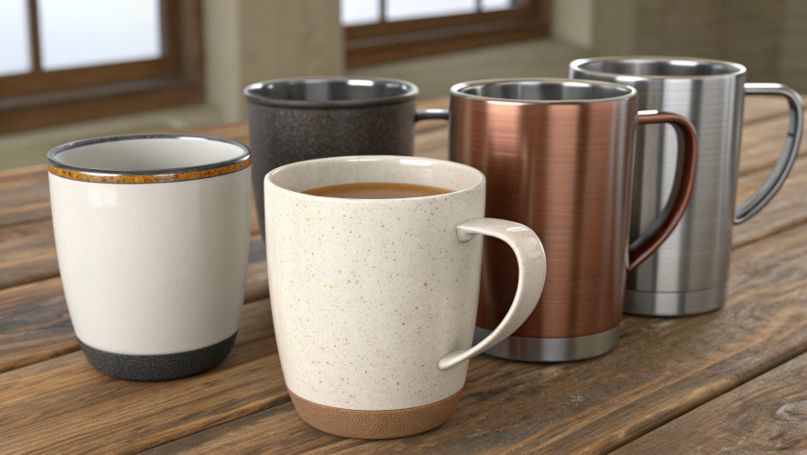
I've spent years working with these materials, from handling raw clay to inspecting the final glazed product on a factory line. For a product developer like you, knowing the subtle differences between them is not just trivia. It's the key to creating a mug that feels right in the hand, keeps coffee warm, and truly represents your brand's quality. Understanding the 'what' is the first step to mastering the 'why' behind a successful product.
Are mugs ceramic or porcelain?
The terms ceramic and porcelain are used so interchangeably. This creates confusion when sourcing materials and risks misrepresenting the final product you worked so hard to develop.
All porcelain is a type of ceramic, but not all ceramics are porcelain. Porcelain is a premium, high-fired ceramic known for its strength and bright white color, while "ceramic" can also refer to stoneware or earthenware.

Think of "ceramic" as the parent category, like the word "tree." Porcelain, stoneware, and earthenware are specific types, like "oak," "maple," and "pine." I once worked with a client who wanted a "ceramic" mug for a high-end coffee shop. I showed them a stoneware sample and a porcelain sample. The moment they held the lighter, finer porcelain, they knew it matched their brand perfectly. Choosing the right specific type is what elevates a product from generic to curated.
The Ceramic Family Tree
As a developer, knowing this hierarchy allows you to make precise material choices. The difference comes down to the clay used and the temperature at which it's fired.
- Earthenware: Fired at the lowest temperatures. It's porous and less durable, requiring a thick glaze. It's affordable but chips easily.
- Stoneware: The most common material for everyday mugs. Fired at a medium-high temperature, it's non-porous, durable, and has a classic, substantial feel.
- Porcelain: Made with fine kaolin clay and fired at the highest temperatures. This makes it incredibly strong, non-porous, and brilliantly white. It can be made thin enough to be translucent.
| Ceramic Type | Firing Temperature | Durability & Feel | Best Use Case |
|---|---|---|---|
| Earthenware | Low (1800°F) | Porous, thick, chips easily. Rustic feel. | Decorative items, casual dishware. |
| Stoneware | Medium (2100°F) | Durable, opaque, good heat retention. Heavy feel. | Everyday mugs, plates, bakeware. |
| Porcelain | High (2300°F) | Very strong, thin, can be translucent. Elegant feel. | Fine dining, premium mugs, teacups. |
What is the safest material for a mug?
Health and safety are critical for your customers. Choosing a material with any perceived risk could destroy your brand's reputation and the trust you've built with your audience.
Glass is the most chemically inert and safest material, as it's non-reactive. However, any modern mug made from certified lead-free ceramic or food-grade 18/8 stainless steel is equally safe and non-toxic.
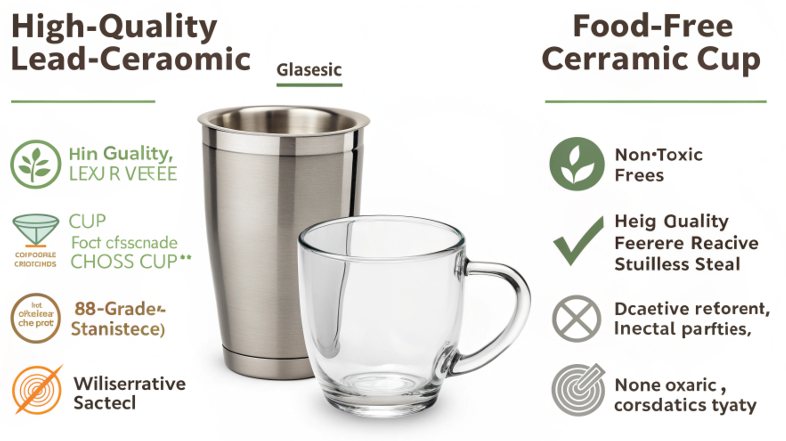
In every product development meeting, my first question is about safety compliance. The answer must be yes. A product isn't viable without it. "Safe" isn't a feature; it's the foundation we build everything else on. For a developer like Emily, this means you don't just ask if it's safe—you demand the test reports that prove it. This is how you protect your customers and your company. Sourcing safe materials is your most important responsibility.
What 'Safe' Really Means for Drinkware
Safety in drinkware means that the material does not transfer any harmful substances to the beverage. Here's a look at the top choices.
- Glass: This is the gold standard for purity. Made from sand, soda ash, and limestone, it's completely non-porous and won't leach any chemicals. Borosilicate glass is even better, as it can handle extreme temperature changes.
- Certified Ceramic: The safety of a ceramic mug is all in its glaze. Modern production ensures this glaze is lead-free and cadmium-free. The high firing temperature fuses it into a solid, inert, glass-like surface that's completely safe for food contact. Your job is to verify this with compliance documents.
- 18/8 Stainless Steel: This is the grade of steel (also called Type 304) used for high-quality food equipment and travel mugs. The "18/8" refers to its composition of 18% chromium and 8% nickel, which makes it highly resistant to rust, corrosion, and chemical reactions with acidic drinks like coffee.
What are most standard mugs made of?
You want to produce a classic, reliable mug. But the term "standard" is vague. Picking the wrong "standard" material could result in a product that feels cheap or doesn't keep drinks warm.
The vast majority of standard mugs are made from stoneware. This type of ceramic provides the ideal balance of durability, heat retention, and cost, creating the familiar "diner mug" feel that most people expect.
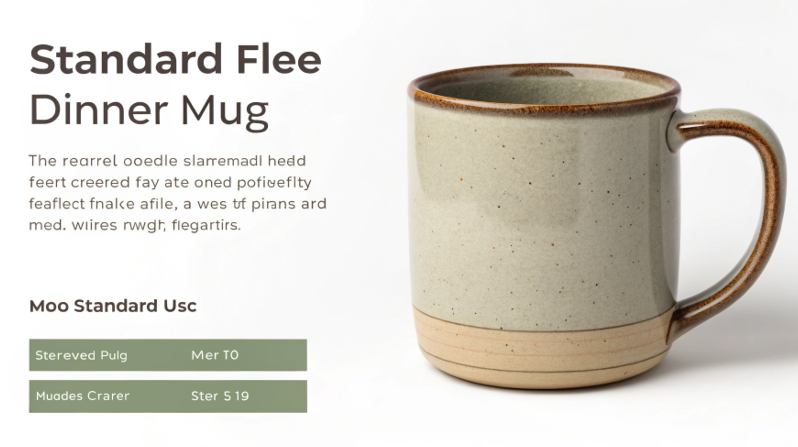
When people think of a "mug," they are almost always picturing a stoneware mug. It's the dependable workhorse of the mug world. I've helped countless brands develop stoneware lines because it just works. It has a reassuring weight in the hand and holds heat well, fulfilling the two most basic needs of a coffee drinker. For a developer starting a new line, stoneware is often the safest and most logical place to start because its qualities are exactly what the mainstream market expects.
Why Stoneware Is the Industry Standard
Stoneware didn't become the default choice by accident. It won out because it excels in the areas that matter most for a high-volume, everyday product.
For a product developer balancing cost, performance, and user perception, stoneware hits the sweet spot.
- Durability for Daily Life: It is significantly tougher than earthenware and more resilient to chipping than many delicate porcelain designs. It's built to withstand daily use, including countless trips through the dishwasher.
- Superior Heat Retention: The naturally thick walls of a stoneware mug are excellent at insulating, keeping coffee and tea hot for longer. This is a core functional benefit that users notice and appreciate every morning.
- The Perfect Feel: Stoneware has a satisfying heft and substance. It feels solid and valuable, not flimsy. This tactile quality is a huge part of the comforting ritual of a hot beverage, improving the overall user experience.
- Cost-Effective Production: The raw materials are widely available and the firing process is more efficient than that for porcelain, making it an economically smart choice for brands producing mugs at scale.
Do all ceramic mugs contain lead?
The word "lead" rightly worries customers. The lingering fear that any ceramic mug could be toxic can harm your brand, making it vital to address this concern with clear facts.
No. Modern ceramic mugs made by reputable manufacturers and sold in regulated markets like the US and EU do not contain dangerous levels of lead. They must comply with strict safety standards for lead and cadmium.
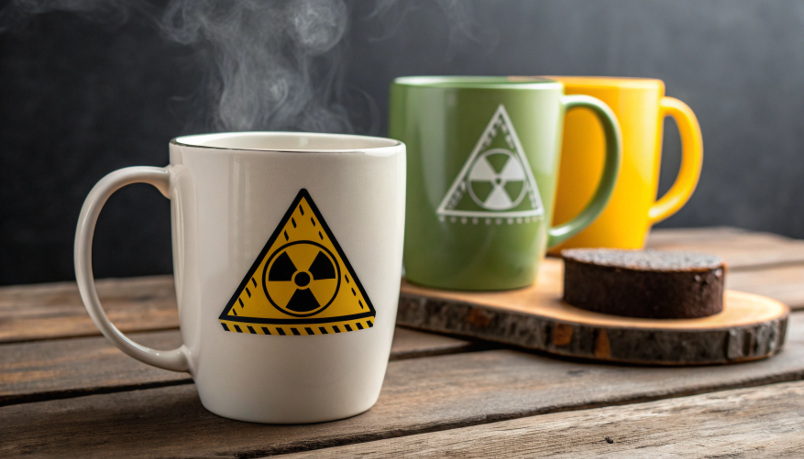
This is a fear rooted in the past, not the present reality of the industry. Decades ago, lead was a common ingredient in glazes to produce bright colors. But today, the legal and financial risks of non-compliance are immense. I tell my clients that any reputable factory prioritizes safety testing because their business depends on it. The problem isn't the material itself; it's the accountability of the supplier. Your job is to choose partners who prove their commitment to safety with documentation.
The Truth About Lead in Modern Ceramics
As a product developer, it's your responsibility to understand and verify the safety of your products. Here is how you can confidently address the lead question.
- Understand the History: Lead was once used to create vibrant red and orange glazes and to lower the firing temperature. This was common practice in older or antique ceramics, and can still be an issue with unregulated products from some regions.
- Know the Regulations: Today, strict government regulations are in place. In the United States, the Food and Drug Administration (FDA) and California's Proposition 65 set very low limits for any leachable lead or cadmium from food-contact surfaces. A mug must pass these tests to be sold legally.
- Demand Verification: This is the most critical step. Do not take a supplier's word for it. You must work with factories that provide recent, valid laboratory test reports from a certified third-party testing agency (like SGS, Intertek, or TUV). These reports are your proof that the specific mugs you are producing are safe and compliant. Avoid anonymous sourcing and always demand the paperwork.
Conclusion
Most mugs are stoneware ceramic, prized for durability and feel. For guaranteed safety and purity in your products, always choose certified lead-free ceramic, pure glass, or food-grade stainless steel from a trusted supplier.


